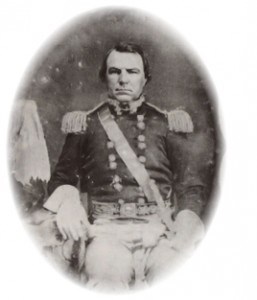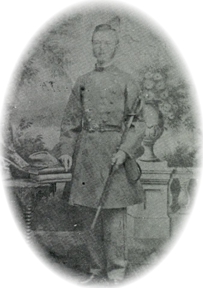 Today’s Military History article continues the story of the Quattelbaum (Quattlebaum) family whose American progenitor, Petter Quattelbaum, arrived in America in October of 1736 (see this past week’s Surname Saturday article here).
Today’s Military History article continues the story of the Quattelbaum (Quattlebaum) family whose American progenitor, Petter Quattelbaum, arrived in America in October of 1736 (see this past week’s Surname Saturday article here).
Johannes Quattelbaum, son of Petter, had seen action in the Revolutionary War, serving under Brigadier General Francis Marion, a.k.a. the “Swamp Fox”. His son John was born on December 1, 1774 in the Saxe Gotha Township, two miles north of present day Leesville, South Carolina. After the war Johannes moved his family to a Dutch settlement on Sleepy Creek, but John returned to his birthplace and married Sarah Weaver on August 5, 1798.
 John and Sarah Quattelbaum had five children together before Sarah died on January 6, 1809. John was left with five young children to raise and the following year he married Metee Burkett, daughter of a fellow soldier who had fought alongside his father Johannes. He and Metee had four sons.
John and Sarah Quattelbaum had five children together before Sarah died on January 6, 1809. John was left with five young children to raise and the following year he married Metee Burkett, daughter of a fellow soldier who had fought alongside his father Johannes. He and Metee had four sons.
Sometime in 1809 John moved his family to a place on Lightwood Creek, about four miles south of Leesville, where he would establish mill operations: a flour mill, grist mill and lumber mill. There he gained a reputation as an industrialist who also manufactured cotton gins and rifles. The development of the last two industries were especially well-timed and profitable – demand for the cotton gin was high and the Quattelbaum rifle was well-known and sold throughout the country.
After receiving a commission as captain of his local militia company, John served during the War of 1812 with Lieutenant Colonel Rowe and the South Carolina Militia in defense of Charleston.
According to family history (Quattlebaum: A Palatine Family in South Carolina), “Captain Quattelbaum was a man of forceful character. He had positive opinions and expressed them readily. His integrity and devotion to duty gained him the respect of all who knew him.” John had been educated entirely in the German language, but would later acquire the English language.
On December 9, 1840, Metee died and near the end of his life John lost his eyesight and lived with his son, General Paul Quattlebaum, until he died there on November 25, 1853.
Brigadier General Paul Quattlebaum
Paul Quattlebaum was born on July 8, 1812 and at the age of three the family moved to the location where the mill operations were established. Perhaps a reflection of his father’s integrity and influence, Paul distinguished himself early in both military and public service. At the age of eighteen he was elected captain of his militia company. On September 3, 1835 he married Sarah Caroline Jones, widow of Samuel Prothro, and the daughter of Colonel Mathias Jones.
Just a short time after his marriage, the governor requested that Paul raise a company of volunteers to fight the Seminole Indians in Florida; he was again elected captain of the company. The following year his company was mustered into federal service in Georgia as part of the First Regiment, Infantry, South Carolina Volunteers. Their campaign in Florida was successful and upon his return home, Captain Quattlebaum was promoted to Colonel of the 15th Regiment, 3rd Brigade, South Carolina Militia in 1839.
 When his boyhood friend, Brigadier General James H. Hammond, ascended to the governorship of South Carolina, Colonel Quattlebaum replaced him and was promoted to Brigadier General in 1843 and served in that position for ten years. Paul Quattlebaum was a busy man – not only serving in the military but in public service to his state and community.
When his boyhood friend, Brigadier General James H. Hammond, ascended to the governorship of South Carolina, Colonel Quattlebaum replaced him and was promoted to Brigadier General in 1843 and served in that position for ten years. Paul Quattlebaum was a busy man – not only serving in the military but in public service to his state and community.
Paul was many things it seems, including industrialist, following in John’s footsteps. He established a successful lumber mill operation – installing perhaps the first water-turbine wheel and the first circular saw to be used in the state. He improved upon John’s flour mill and Quattlebaum flour was marketed throughout South Carolina. The mill would also later furnish flour for the Confederate Army.
The Quattlebaum rifle continued to be manufactured as well, its reputation maintained by Paul’s leadership and oversight. It is believed that General Quattlebaum introduced the first percussion-cap locks in the state, mounted by on gun barrels made in his factory. Flint and steel locks were made obsolete by this innovation and the rifles were used by the Confederate Army.
From 1840 to 1843 he served as a state representative and from 1848 to 1851 as a state senator. In the 1830’s he had been a member of the short-lived Nullifier Party which supported states rights to the extent they believed that federal laws could be ignored (nullified). In line with advocating states rights, Paul later became a secessionist – as both a member of the Secession Convention and signing the Ordinance of Secession.
Paul Quattlebaum, however, would be precluded from field service during the Civil War due to a back injury and his advanced age. He did provide counsel to the Confederate Army and took a small part in defending the area around Columbia during the war. His home, as a signer of the Ordinance of Secession, was targeted for destruction by fire. The major in charge of carrying out the attack, personally set fire throughout the house while his men ransacked. However, the family’s slaves were able to help the family save the house.
Paul Quattlebaum died at the age of seventy-eight years in 1890. Two of his sons, Paul Jones and Theodore Adolphus served during the Civil War, both noted for distinguished and historic service.
Theodore Adolphus Quattlebaum
Theodore was born on May 11, 1842 and on January 1, 1860 entered the Arsenal Academy in Columbia to begin his military career. By the following January, it appears he had transferred to the Citadel in Charleston because he was on hand for what came to be considered the first shots of the Civil War (although it didn’t officially start for another three months).
South Carolina had just seceded a few weeks before and on January 9, 1861 Citadel cadets fired upon the Star of the West, a civilian steamship which had been hired by the federal government to deliver supplies to Fort Sumter. While the ship didn’t suffer serious damage, the captain decided it best to abandon the mission.
 Theodore left the Citadel and enlisted as a private in Company K, 20th Regiment, Infantry under the command of Captain W.D.M. Harmon on December 31, 1861. By April of 1862 he had been promoted to second sergeant and steadily moved up the ranks until his promotion to lieutenant in 1864. Company K was engaged in fighting around Averysborough, North Carolina in 1865 at the Battle of Smith’s Farm.
Theodore left the Citadel and enlisted as a private in Company K, 20th Regiment, Infantry under the command of Captain W.D.M. Harmon on December 31, 1861. By April of 1862 he had been promoted to second sergeant and steadily moved up the ranks until his promotion to lieutenant in 1864. Company K was engaged in fighting around Averysborough, North Carolina in 1865 at the Battle of Smith’s Farm.
Although the battle ended as a draw, Lieutenant Theodore Adolphus Quattlebaum was mortally wounded on March 16, 1865 and died the following day. He had been fighting a rear guard action and covering the retreat of General Joseph E. Johnson when he was felled. His body was buried in a marked grave by his body servant and later his remains were transferred to the family cemetery in Lexington County, South Carolina.
Several other members of the Quattlebaum family served during the Civil War. In fact, according to Ancestry.com, there were forty-seven Quattlebaums who served the Confederacy – none in the Union Army, however. This family, with German roots, was Southern to the core.
 Did you enjoy this article? Yes? Check out Digging History Magazine. Since January 2018 new articles are published in a digital magazine (PDF) available by individual issue purchase or subscription (with three options). Most issues run between 70-85 pages, filled with articles of interest to history-lovers and genealogists — it’s all history, right? 🙂 No ads — just carefully-researched, well-written stories, complete with footnotes and sources.
Did you enjoy this article? Yes? Check out Digging History Magazine. Since January 2018 new articles are published in a digital magazine (PDF) available by individual issue purchase or subscription (with three options). Most issues run between 70-85 pages, filled with articles of interest to history-lovers and genealogists — it’s all history, right? 🙂 No ads — just carefully-researched, well-written stories, complete with footnotes and sources.
Want to know more or try out a free issue? You can download either (or both) of the January-February 2019 and March-April 2019 issues here: https://digging-history.com/free-samples/
Thanks for stopping by!


This is my family, a part of my heritage. I am so proud of my roots. Thank you granddaddy for all the family history lessons.
Glad you enjoyed the article … you should be proud of your heritage!
??
My material grandfather was Justin Arvil Rushton, his mother was a Quattlebaum. He lived in Saluda county, his brother, Wilber Rushton ran the farm after granddaddy left for Georgetown, SC and also had a construction company. I’m very proud to be a part of the family tree. Granddaddy was such a protectionist, I wouldn’t cut his grass, it was crazy, but I miss him terribly. I lost him in 1989, I was only 19, living on my own trying to make it. The sun rose and set with him in my eyes. We had a great relationship with much love and respect for each other.
What a great story and what a great heritage you have! Thanks for stopping by!
What was Paul’s middle name?
I never saw a reference to his middle name… kinda curious isn’t it?
. The first three men mentioned in this article are Petter Quattelbaum (original spelling), Johannes Quattlebaum, and his son Captain John Quattlebaum. They are in order my 6xGreat, 5xGreat, and 4xGreat Grandfathers. The latter a very influential gentleman in the history of South Carolina. Nancy K Quattlebaum & brother Kevin Quattlebaum
Excellent! You come from “good stock” as they say. Thanks for stopping by!
I’d love to find a Quattlebaum rifle since I am a descendent… Does anyone know where I can find one?
That would be quite a find and if found might be a pretty penny!
The Lexington County Museum in Lexington, SC has a rifle.
The one in the Lexington County Museum is a flintlock. There is also a Quattlebaum sporting flintlock in the Confederate Relic Room in the State Museum in Columbia.
I live about 2 miles from Captain John Quattlebaum’s old home place. The original house is still standing. It has been moved several hundred yards. You will have a hard time finding a Quattlebaum rifle. My grandfather had several and later, my Uncle Paul Quattlebaum owned them. They were stolen from my Uncle Paul’s house years ago and never recovered. Miss Laura Brodie, who used to live on Captain John’s old home place, owned several of the last known privately owned rifles. Upon her death they were sold at auction to the highest bidder. My family still owns and lives on part of the land that used to be the old Johannes/Captain John/General Paul estate. As a child I used to swim in the creek at General Paul’s old home place and at Captain John’s. The first electricity produced for the Batesburg-Leesville area was produced at Captain John’s. He used to float logs down the creek all the way to Charleston. I’ve heard stories how slaves would float the logs down the creek to Charleston and then would walk home. My Grandfather was E V (Buck) Quattlebaum. He took me to the cemetery to see their graves. He used to take my sister and me hunting and fishing all over the land. It is still “Quattlebaum” land to me and my family. My grandfather taught me about my heritage all my life. Now, it’s my turn. I’m teaching my children and grandchildren of their great heritage. I truly am a proud descendant of a Confederate soldier…and then some!
Thanks for stopping by and sharing. So glad to hear you are teaching your children about your family history.
my name is William James(jay) Rachels, son of Edith Quattlebaum, daughter of William James Quattlebaum, son of Charles Quattlebaum, son of B.Gen. Paul Quattlebaum….nephew of William James Quattlebaum jr.aka ‘Uncle Rooster’ and aunt Margret Quattlebaum
Hello Denise, A few years later (today!) I found your comments above
about the Quattlebaum family. John Quattlebaum was my 3rd great grandfather. I would love to visit the land and homeplace you mention. I live in PA but will be coming to SC before Christmas this Dec 2019. Would you be willing to meet and show me the homeplace?
Where do you live?
Great article I also hail from Quattlebaum my great grandfather was Connie Quattlebaum. I am the first born male from his 2nd daughter. There is Quattlebaum road a cemetery and a church where his only son is buried as an infant “James gary”. I have attended mt Hebron for 6 weeks in a row here in central Arkansas
Thanks for stopping by and sharing!
Proud Quattlebaum here! Proud today my southern heritage and my family!!
Excellent … and proud you should be! Thanks for stopping by!
I descend from George Washington Quattlebaum and his son Col John Quattlebaum, wife Elizabeth Youngblood. I am currently trying to connect George and John with documentation. Is there a family Bible out there somewhere?
Great article about my gggg-grandfather. I am the youngest of 3 sons of Joseph Riley Quattlebaum whose father was Thomas Paul Quattlebaum, son of Phillip M Quattlebaum, son of George Washington Quattlebaum, son of Johannes. I wish I had seen this article earlier. Phillip Quattlebaum is buried at the Quattlebaum cemetery on Harmony Mountain one mile north of Bee Branch, Arkansas on Hwy 65. Phillip donated the land for the cemetery to the community. I have several relatives buried there and as a child I attended “decoration day” on the 2nd Sunday in May (Mothers’ Day) with my parents.
Otis Crawford Quattlebaum
[email protected]
Portland, Oregon
Thank you Otis for stopping by. So glad you enjoyed the article!
Hello,
My name is Leslie Olejnik and I am doing some research on the Quattlebaum family. I was wondering what is in your genealogical file? I am specifically trying to connect George Washington Quattlebaum with his son Col John Quattlebaum. Maybe there is a bible record or something. Col. J Quattlebaum married Elizabeth Youngblood and I have proven that line for DAR. I just need some documentation connecting George W. Quattlebaum with his son Col John Quattlebaum. Several members of the Quattlebaum family moved to Alabama in the 1830s but Col JOhn and wife Elizabeth stayed behind. Col John Quattlebaum died in 1865 and left a Will which I have a copy of. Father George W. died in Alabama left no Will but his second wife did, however; it doesn’t mention John because he was already deceased.
Any help would be greatly appreciated. -Leslie Olejnik
Hi Leslie, Otis is my father, and we are the Arkansas descendants of Philip Quattlebaum, George’s son. I think George and Philip moved from Alabama to central Arkansas – not sure if George was with Philip when he moved to Arkansas. I don’t recall hearing about a son of George’s named John. Have you researched the Quattlebaum Family History book? Let me know if you need a copy.
Thanks, Brian Quattlebaum
[email protected]
Interesting read. I trace back to Mathias Quattlebaum, Johanne’s brother. I have the Robert Mills’s survey of the Lexington district which has his home place designated. I had the good fortune of visiting with Mrs Brodie years ago. Last time I was at the confederate museum a Quattlebaum rifle was on display.
My mother was a Quattlebaum. I live in Batesburg Leesville, South Carolina. General Paul is a grandparent. I have been to his gravesite many times. The old mill site is off Bagpipe Road.